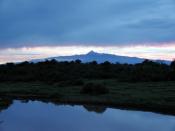Climate Report: Kenya
Kenya covers an area of approximately 224,960 square miles, slightly smaller than the state of Texas, and is situated in East Africa between 5ð N and 5ð S. It has a very diverse relief with a low coastal plain on the Indian Ocean shore, extensive inland plateau regions between 15 m/3,000 ft and 1,500 m/5,000 ft and several mountain ranges and isolated peaks such as Mount Kenya, which rises to 5,200 m/17,000 ft which has a permanent snow-cap. This geographical and climatic diversity has led to distinct distributions of vegetation, animal life, and human activity within Kenya.
Climate: Global and Regional Factors
As Kenya straddles the equator, the rainy seasons reflect the biannual passage of the Intertropical Convergence Zone (ITCZ), the equatorial trough of low pressure, across the country - southward early in the year and northward in the second half of the year. However, the influence of this global circulation system is greatly moderated by regional monsoon flows, such that Kenya's climate is best described as monsoonal.
Although several factors produce monsoons, including the shifting of the ITCZ, the primary cause are the annual temperature trends over land and sea. In fact, the large changes in pressure over the land mass interior enforce and exaggerate the shifting of the ITCZ (Oliver and Hidore 117). Because of the relatively low heat capacity of Earth materials compared with water, continents heat and cool more rapidly with the seasons. This results in large seasonal changes in temperature over land but small changes over ocean waters, bringing with it marked reversal in wind and moisture conditions.
In general, Kenya's climatic patterns are reflected in its four distinct seasons and correspond with the migration of the ITCZ and monsoonal flows. However, it is important to note that although Kenya straddles the...


